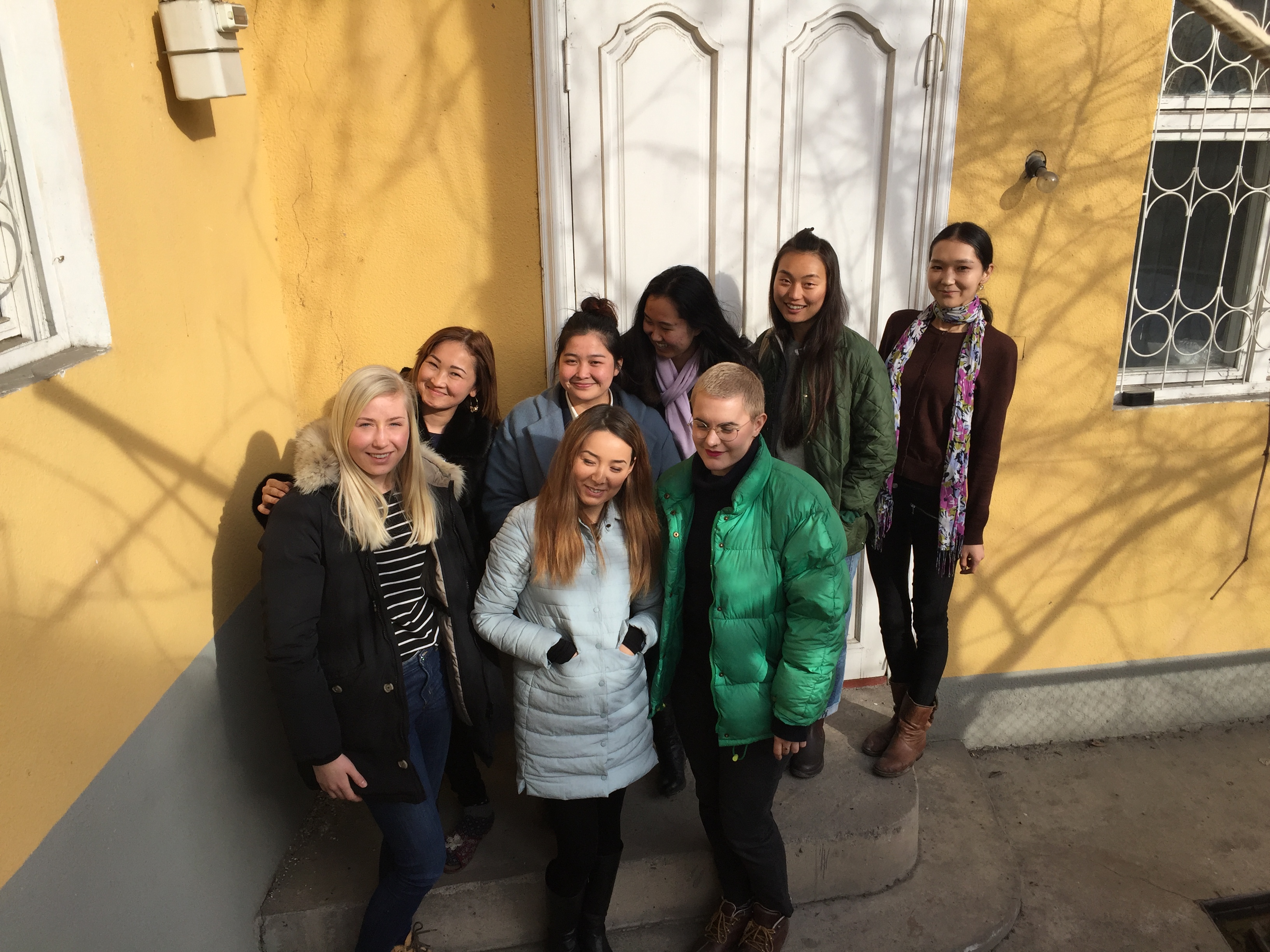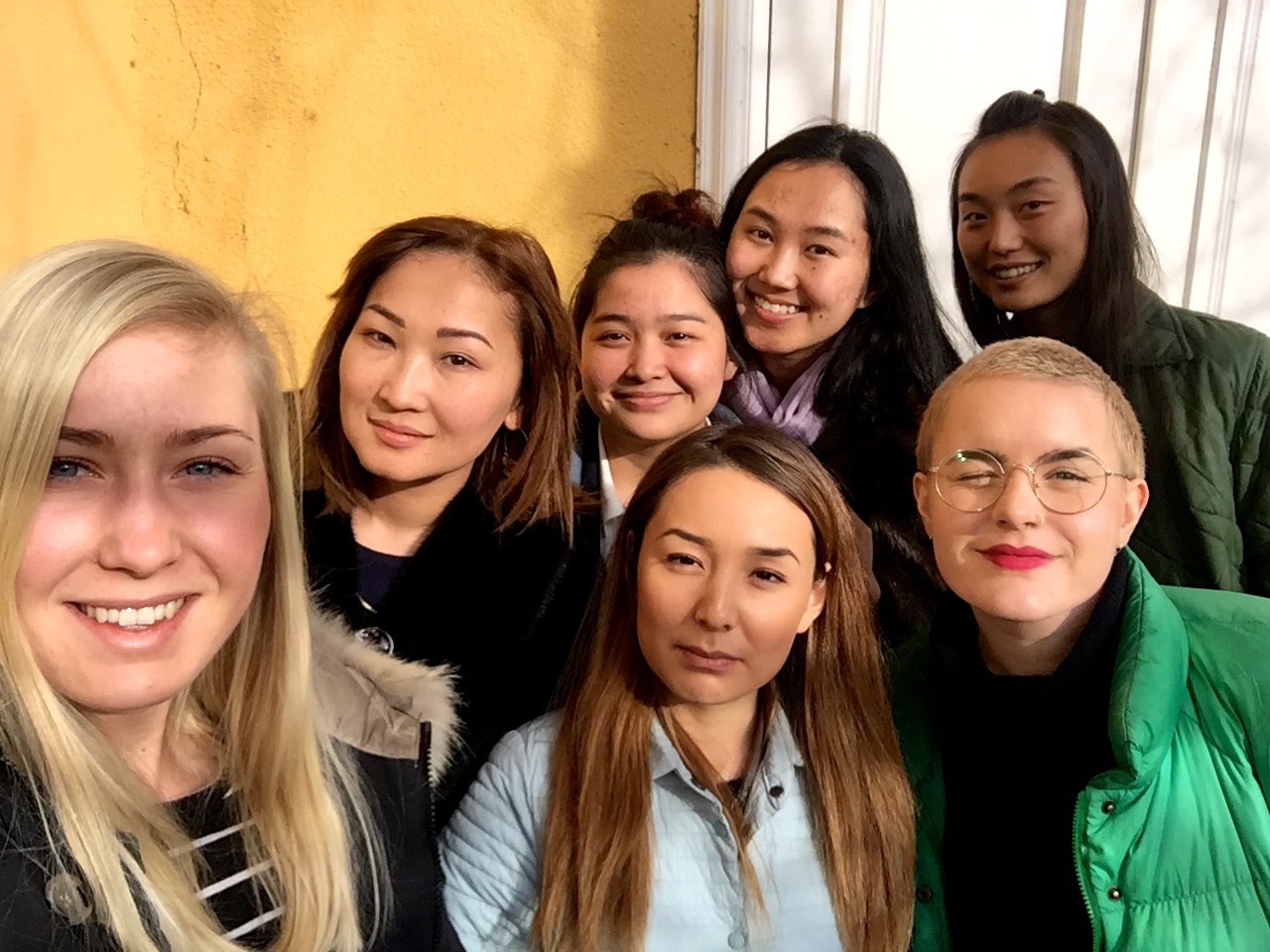Disclaimer: CAG is a politically and religiously unbound organization and this blog post mirrors only my own thoughts in connection to this workshop and from spending only one week in Kyrgyzstan. It should also be underlined what is being presented is a small part of the research conducted on the subjects of Islam and feminism, ethnicity and gender.
This Friday the staff of Novi Ritm participated in a small workshop about Islam and feminism, which was facilitated by Grace Zhou, an anthropologist who writes her dissertation on gender and informal economy here in Kyrgyzstan. On the picture above you can see the participants from the workshop.
After the workshop I tried to dig deeper into different aspects of how one can understand ethnicity and gender in Kyrgyzstan and also tried to understand how to approach the relationship between Islam and feminism. Ethnicity and its implications affect women and men in different ways and as Megoran (1999) puts it, “no explanation can be complete if half of its subject matter is enslaved in non-presence”. Moreover, Handrahan (2001) highlights the importance of gender in the understanding of ethnicity since “male definitions of ethnicities and their gendered identities are resulting in extremely high levels of violence against women”. The previous intern Bella, has written two blogpost about national identity and women’s roles in the construction of identity, you can find them here. The definition of national identity and gender is presented in her blogpost and I’ll have the same understanding of the concepts in this blogpost. My aim is to interweave the discussion from the workshop with an article from Handrahan (2001) and to understand more about the relationship between Islam and feminism since it is of relevance for Novi Ritm as an organization.

Handrahan (2001) explains at least five competing socio-political processes in the consolidation of the Kyrgyz’s identity, all with their own definitions of what it means to be a woman. Four of them will be described and reflected upon here:
(1) Communist-Marxist-Leninist-Stalinist ideological foundation,
(2) Influence of Islamic/Muslim fundamentalism
(3) Indigenous processes of ‘remembering’ nomadic and tribal traditions
(4) Influence of Western democratic assistance.
Historical background and the USSR
In order to understand issues related to Kyrgyz ethnicity, a bit of historical background is needed. Kyrgyzstan became an independent country from the Soviet Union with the fall of communist state in 1991, which means that a lot of Kyrgyz’s culture has its influences from the Soviet heritage. As a matter of fact, Kyrgyzstan as a country was created alongside the fall of the Soviet Union.
The Soviet ideal of a woman was to portray her as the “Soviet mother” since the women were “producing, mobilizing and controlling the population”(Handrahan, 2001). The ideal woman was a mother – who even could be awarded as the Hero of the USSR if she had more than six children. This relates to the first process. Handrahan (2001) describes women’s appearances and sexuality as something important for the nation and that she should be desirable for men. When I have been talking to Kyrgyz’s people the segment of a woman as a child bearer seems to be an important aspect of the ethnicity and of how women identify themselves; even the tradition of having six children was mentioned by a woman that I was talking to.
Islam
Under the Soviet system atheism was the official doctrine and the state denied access to religious knowledge and greatly restricted its practices. This led to a loss of religiousness (Heyat, 2004). When the USSR fell, a backlash in the search for cultural identity began, with increasing contact with the Muslim world (Heyat, 2004).
During the workshop we discussed that there are Imams from different Islamic traditions and that they are affecting the people that are going to the Mosques in different ways and also that the southern parts of the country is considered to me more conservative then the north. This connects to the second process about the new influence of Islam and the fact that there are different forms of how Islam manifests in Kyrgyz’s society. Handrahan (2001) explains that for instance, Turks and Saudis try to bring Central Asia under their influence. So, how does this relate to gender and ethnicity? Well the renewal of traditions has increased male power in some cases, Handrahan (2001) exemplifies with some situations, which are relevant for women:
-Kalym, the price that are paid to acquire a bride
-A widow shouldn’t marry anyone else but could only marry someone from her dead husbands family, e.g. a brother of the dead husband
-Bride kidnapping
To get an idea about how the connection between Islam and feminism, we started the workshop by watching a short documentary about an American scholar and Muslim named Amina Wadud and her ideas about feminism and Islam, link here.
The main message from Amina Wadud is that no human can be above another since Allah is on top, therefore women should not be subordinate to the man, but also that every individual are responsible for his/her relationship to God. Islamic feminism can be described as the wide variety of Muslim women’s profaith work against sexism and male domination (Badran in Aysha A. Hidayatullah ,2014). During the workshop we discussed the fact that there has never been a woman who interpreted the Koran (Tafsir) and that this should be changed. Aysha A. Hidayatullah (2014) describes that what is challenged in Qur’an-based Islamic feminism is ”not only traditional authority in general, but specifically men’s exclusive authority to interpret the Qur’an”.
We discussed how important it is to separate what is actually said in the Koran and what is historical traditions. Another aspect, which was discussed during the workshop, is that women only get small areas in the Mosque for praying and how men’s belief is considered more “important” in some ways. To exemplify: one participant in the workshop described how, when she was a kid, men came and knocked on her door and asked if there were a husband or brother in her family that could go to the Mosque. Since there were only girls in her family she always said no, and thought that only men were the ones that could go to she Mosque. When she turned 20 she finally went to a Mosque and the Imam told her that this was a place for everyone. The point is that Islam is interpreted and understood in many different ways, which affect both women and men in society.
At the same time it should be underlined that there are a lot of women who doesn’t practice Islam and don’t wear hijab, which is often seen as an individual choice but paradoxically, women from more conservative families are sometimes considered to be a “better Muslim” if they wear the hijab, according to some participants in the workshop, so social pressure is something that could be included in the understanding of how women are expected to act and behave.
Tribalism and western democratic influence
The third process that Handrahan (2001) discusses is Tribalism. In the search of a national identity after the fall of USSR, many people have returned to their tribal roots. The relation between tribalism and gender is that power is reserved only for certain male biological descendants, for example the use of Aksakal courts where the oldest man in the village makes all the decisions. This wasn’t discussed during the workshop but is of course relevant to the understanding of gender and ethnicity.
The last, fourth, process is the one of western democratic influence. Handrahan (2001) explains how in Kyrgyzstan male “experts” were sent from the US in order to help the country when it was still in it’s cradle and how women’s role in the democratic process wasn’t included. This has led to women becoming disregarded as potential political leaders in Kyrgyzstan, even though they would have been qualified through their leadership of civil society/NGOs.
To sum up, a gender perspective is important when you try to understand ethnicity and identity since historical heritage and religion is affecting and expecting different things from women and men. Islam and feminism could be understood through the simple understanding that men and women are equal and that no one should be above another.
/Emma
References:
Lori M. Handrahan (2001) Gender and ethnicity in the ‘transitional democracy’ of Kyrgyzstan, Central Asian Survey, 20:4, 467-496, DOI: 10.1080/02634930120104645
Farideh Heyat (2004) Re-Islamisation in Kyrgyzstan: gender, new poverty and the moral dimension , Central Asian Survey, 23:3-4, 275-287, DOI: 10.1080/0263493042000321371
Aysha A. Hidayatullah (2014) Feminist Edges of the Qurán. Published to Oxford Scholarship Online, DOI: 10.1093/acprof:oso/9780199359561.001.0001
Nick. Megoran (1999) Theorizing gender, ethinicty and the nation-state in Central Asia. Central Asian Survey 18:1, 99-110

